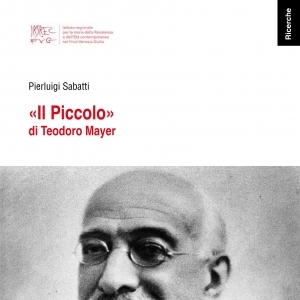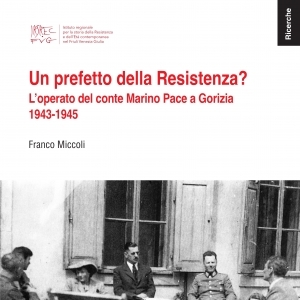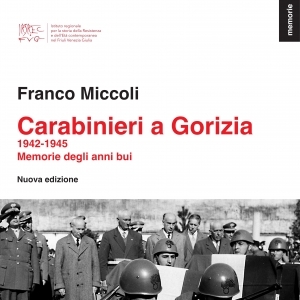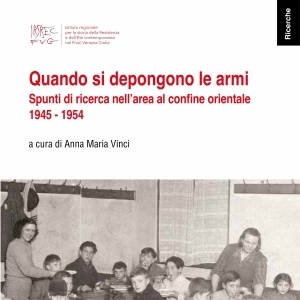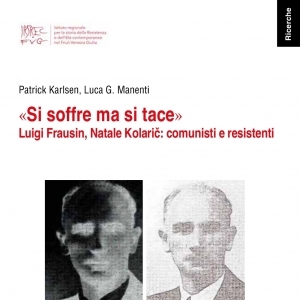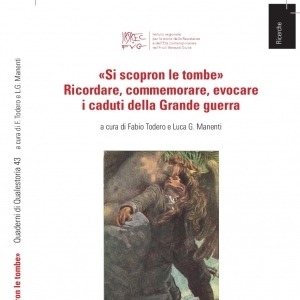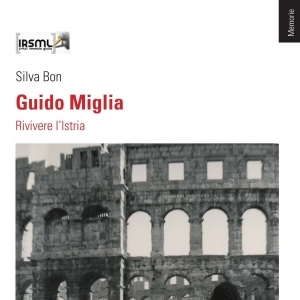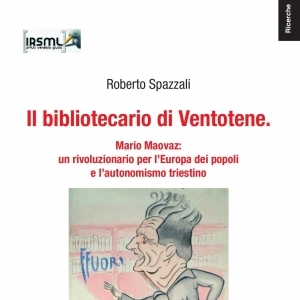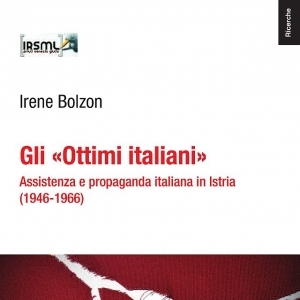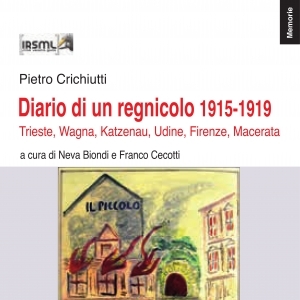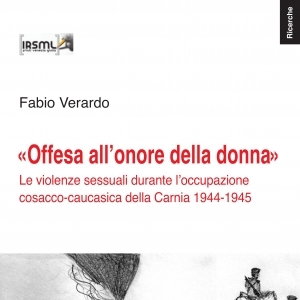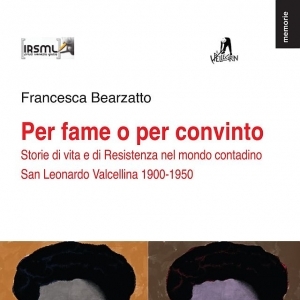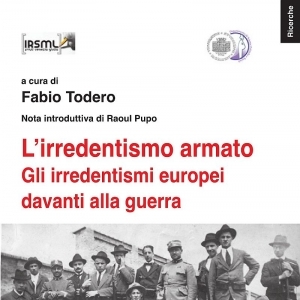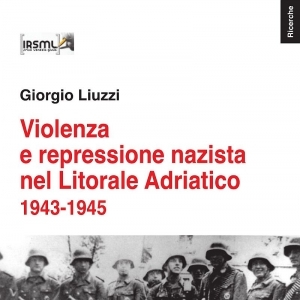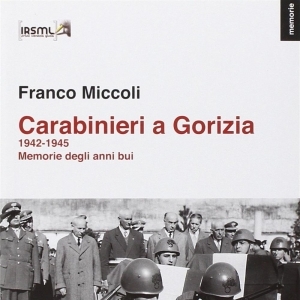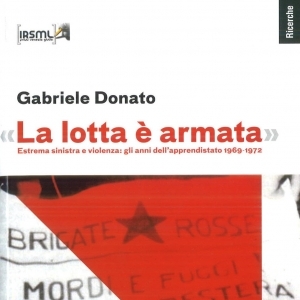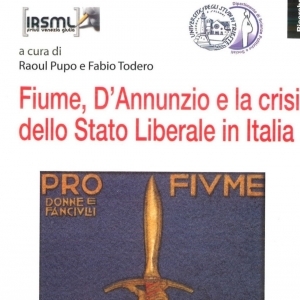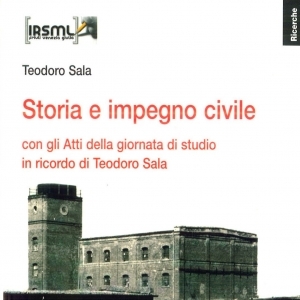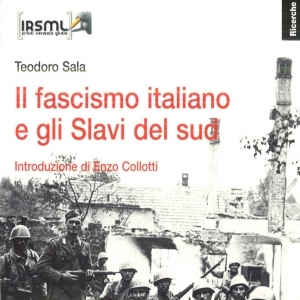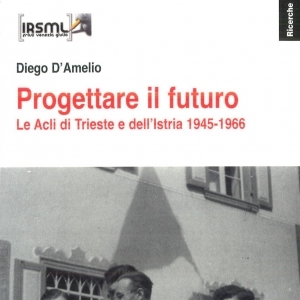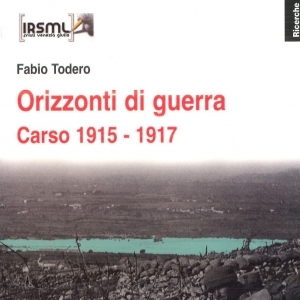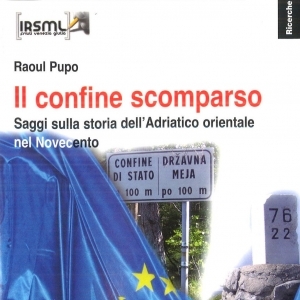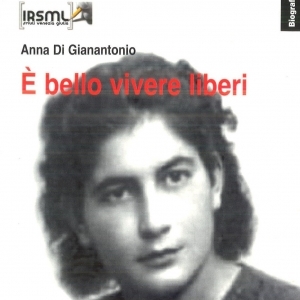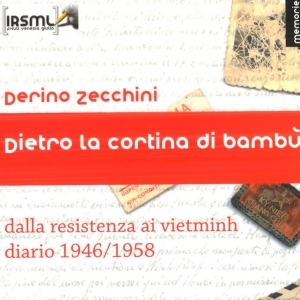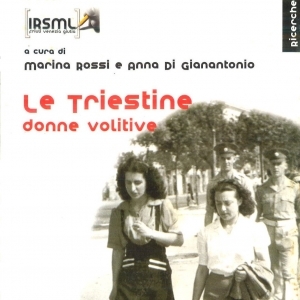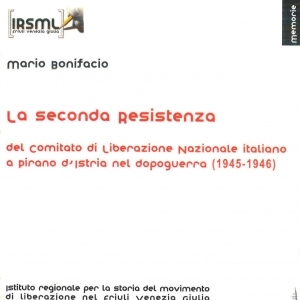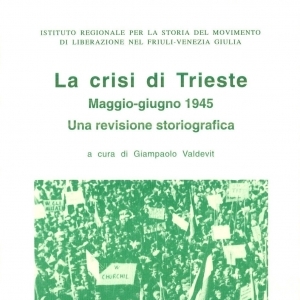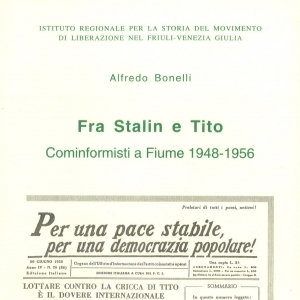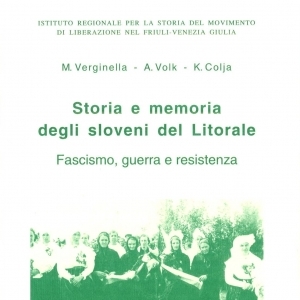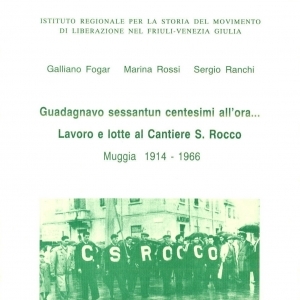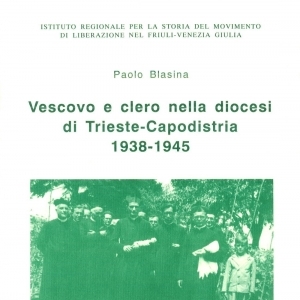Qualestoria 2/2020 - L’impresa di Fiume Memorie e nuove prospettive di ricerca
a cura di Fabio Todero
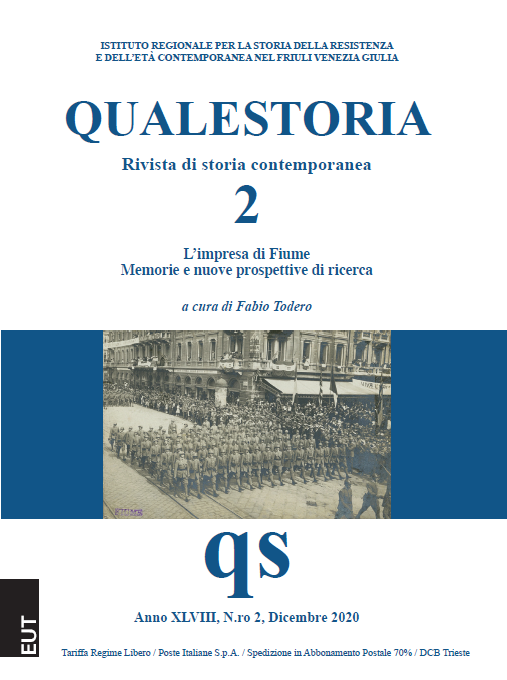
Qualestoria, n. 2, dicembre 2020, anno XLVIII
SOMMARIO - CONTENTS
L’impresa di Fiume. Memorie e nuove prospettive di ricerca
The Fiume enterprise. Memories and new research perspectives
a cura di Fabio Todero
Fabio Todero, Introduzione
Studi e ricerche - Studies and researches
Adriano Andri Echi dell’impresa di Fiume nelle scuole giuliane - Echoes from the Fiume enterprise in the Venezia Giulia schools
Giovannella Cresci Marrone D’Annunzio e il mito di Roma: il contributo dell’epigrafia - D’Annunzio and the myth of Rome: the contribution of epigraphy
Natka Badurina I croati di Fiume ai tempi di D’Annunzio - The Croatians of Fiume in the time of D’Annunzio
Ivan Jeličić Repubblica con chi? Il movimento socialista fiumano e il giallo Sisa nel contesto postasburgico fiumano - Republic with whom? The Fiume socialist movement and the Sisa affaire in Fiume’s post-Habsburg setting
Ágnes Ordasi “Scale e Serpenti”? Le condizioni dei rappresentanti del potere dello Stato ungherese dopo la Grande guerra - “Snakes and ladders”? The condition of the representatives of the Hungarian State power after the WWI 113 137 159 179 189 201
Giovanni Stelli Le elezioni dell’Assemblea costituente dello Stato libero di Fiume: ordine pubblico e lotta politica a Fiume dal 5 gennaio al 5 ottobre 1921 - The elections of the Constituent Assembly of the Free State of Fiume: public order and political struggle in Rijeka from 5 January to 5 October 1921
Giulia Caccamo Origini e fallimento dell’idea di città libere dopo la prima guerra mondiale. I casi di Memel e Danzica - Origins and failure of the idea of free cities after WWI. The cases of Memel and Danzig
Documenti e problemi - Records and issues
Luca Irwin Fragale La massoneria nel senato fascista: dati statistici - Freemasonry in the fascist senate: statistical data
Speciale Fiume
Un Fiume di Storie: Ronchi-Fiume 1919-2019. Mostra documentaria
Andrea Ferletic Attilio Adami, ritratti di un granatiere e legionario a Fiume - Attilio Adami, portraits of a grenadier and legionary in Fiume
Roberto Del Grande A Ronchi nessuna foto di D’Annunzio. Leggere le immagini della storia In Ronchi no photo of D’Annunzio. - Reading the pictures of history
Populismo e femminile nella Fiume dannunziana
Enrico Serventi Longhi The Triumph of the Noble People: Gabriele D’Annunzio and Populism between literature and politics
Giusy Criscione Donne a Fiume tra libertà di pensiero e dissoluzione - Women in Fiume between freedom of thought and dissolution
Messa a fuoco: la parola agli storici - Focus: historians speaking
Città libera
Intervengono Paolo Borioni, Giulia Caccamo, Raoul Pupo
Note critiche - Reviews
Aurelio Slataper Filippo Boni, L’ultimo sopravvissuto di Cefalonia. Dai campi nazisti ai gulag sovietici, l’incredibile storia di Bruno Bertoldi, un eroe qualunque, Longanesi, Milano 2019
Gabriele Donato Enrico Deaglio, La bomba. Cinquant’anni di Piazza Fontana, Feltrinelli, Milano 2019
Lorenzo Nuovo Massimo De Sabbata, Tullio Crali. Il futurismo giuliano e l’aeropittura, Fondazione CRTrieste, Trieste 2019
Anna Di Gianantonio Mimmo Franzinelli, Alessandro Giacone, 1960. L’Italia sull’orlo della guerra civile: il racconto di una pagina oscura della Repubblica, Mondadori, Milano 2020 Alessandro Mella Carmine Pinto, La guerra per il Mezzogiorno. Italiani, borbonici e briganti 1860- 1870, Laterza, Bari-Roma 2019
Recensioni tematiche
Jacopo Bassi Giuseppe Antonio Borgese, I Balcani 1917- 1919. La missione in Albania e la questione jugoslava con scritti e fotografie inedite, a c. di Riccardo Cepach, Ilaria de Seta, Luglio, Trieste 2019 213 223 231 235 239 243 245 249
Luca Zorzenon Dino Terra, D’Annunzio e il caso Fiume, a c. di Paolo Buchignani, Marsilio, Venezia 2018
Adriano Andri Un mondo nuovo (1919-1924). L’ex Litorale austriaco tra fatti di Storia e storie di uomini, a c. di Annalisa Giovannini, Società istriana di archeologia e storia patria, Trieste 2019
Luca Zorzenon Marco Mondini, Fiume 1919. Una guerra civile italiana, Salerno, Roma 2019
Luca G. Manenti Maurizio Serra, L’Imaginifico. Vita di Gabriele D’Annunzio, Neri Pozza, Vicenza 2019
Ivan Jeličić Sanja Simper, Židovi u Rijeci i liburnijskoj Istri u svjetlu fašističkog antisemitizma (1938.-1943.), Židovska vjerska zajednica Bet Israel u Hrvatskoj, Zagreb 2018
Gli autori di questo numero
Adriano Andri collabora con l’Istituto regionale per la storia della Resistenza e dell’Età contemporanea nel Friuli-Venezia Giulia. Si occupa principalmente della storia delle istituzioni scolastiche in ambito locale. Ha pubblicato saggi sulle riviste «Qualestoria», «Materiali di lavoro», «Clio». È autore, insieme a Giulio Mellinato, dei volumi Scuola e confine. Le istituzioni educative della Venezia Giulia (Irsml FVG, 1994) e Scuola e guerra fredda. Le istituzioni educative a Trieste 1945- 1954 (Irsml FVG, 2001); ha partecipato ad alcuni volumi collettivi, tra cui Friuli e Venezia Giulia. Storia del ’900 (Leg, 1997) e «Si scopron le tombe». Ricordare, commemorare, evocare i caduti della Grande guerra, a cura di Fabio Todero e Luca G. Manenti (Irsml FVG, 2018).
Natka Badurina è professoressa associata di Lingua e letteratura croata e serba all’Università di Udine. Le sue ricerche riguardano relazioni italo-croate, elaborazioni letterarie di eventi storici, memoria di violenze politiche, testimonianza e teoria del trauma. Tra le sue pubblicazioni recenti: D’Annunzio a Fiume: la violenza politica, l’etica e la storia, in Fiume 1919-2019 (Il Vittoriale, 2020); Gabriele D’Annunzio i dva suvremena umjetnička projekta («Poznańskie Studia Slawistyczne», 2019); The memory of Italian concentration camps in Croatia, in Miejsca (nie) Pamięci (Muzeum Historyczne Miasta Krakowa, 2019); con Roberta Altin: Divided Memories. Istrian Exodus in the Urban Space of Trieste (in Memory. Identity. Culture II, a c. di I. Novikova et al., Riga 2018).
Giulia Caccamo è ricercatrice in storia delle relazioni internazionali all’Università degli Studi di Trieste. Tra le sue pubblicazioni: L’Organizzazione internazionale per i rifugiati e i profughi giuliani, in Naufraghi della pace. Il 1945, i profughi e le memorie divise d’Europa (Donzelli, 2008); Esserci a qualsiasi costo. Albania, Mediterraneo orientale e spedizioni minori, in La vittoria senza pace. Le occupazioni militari italiane alla fine della Grande Guerra (Laterza, 2014); Il sogno infranto. La grande scommessa degli arbitrati internazionali e del controllo degli armamenti, in Profeti inascoltati. Il pacifismo alla prova della Grande Guerra (Gorizia-Trieste, 2015).
Giovannella Cresci Marrone è professore ordinario di Storia romana all’Università Cà Foscari Venezia. I suoi principali interessi di ricerca riguardano lo studio del trapasso dalla repubblica al principato in Roma antica, l’epigrafia latina in contesti municipali italici, il riuso dell’antico in età moderna. Fra le sue principali monografie figurano, anche in coautoraggio: Pisaurum I. Le iscrizioni della colonia (Giardini, 1984); Per Pagos vicosque. Torino romana fra Orco e Stura (Editoriale Programma, 1988); Ecumene augustea. Una politica per il consenso (L’Erma di Bretschneider, 1994); Microstorie di romanizzazione. Le iscrizioni del sepolcreto rurale di Cerrione (Edizioni Ca’ Foscari, 2013); Roma antica. Storia e documenti, (il Mulino, 2014); Marco Antonio (Salerno, 2020).
Ivan Jeličić ha conseguito nel 2017 il dottorato di ricerca in storia all’Università degli Studi di Trieste, discutendo una tesi sul socialismo fiumano nel tardo periodo asburgico. Attualmente è ricercatore postdoc all’Istituto di storia politica a Budapest all’interno dell’ERC Nepostrans ‒ Negotiating post-imperial transitions, collaboratore esterno al Dipartimento di storia e al Dipartimento di italianistica della facoltà di filosofia di Fiume e collaboratore al progetto Rijeka in Flux: Borders and Urban Change after World War II. I suoi interessi di ricerca sono le trasformazioni politiche e sociali fra Otto e Novecento e i processi di transizione dall’impero asburgico verso i nuovi Stati nell’Alto adriatico, in particolare nell’area fiumana. Tra le sue ultime pubblicazioni: The Typographers’ Community of Fiume: Combining a Spirit of Collegiality, Class Identity, Local Patriotism, Socialism, and Nationalism(s) («Austrian History Yearbook», 2018) e Is There Space for Remembering the Habsburg First World War in Rijeka? Considerations on the Heroic Sailor Monument in Sušak («Spiegelungen», 2020).
Ágnes Ordasi ha conseguito il dottorato di ricerca in storia contemporanea alla Károli Gáspár University of the Reformed Church di Budapest (Ungheria). Si interessa di metodologia, rapporti tra lo Stato-nazione e l’élite locale a Fiume, la “colonizzazione” asburgica della regione balcanica. Tra le sue pubblicazioni: Egan Lajos naplója. Impériumváltások Fiumében a kormányzóhelyettes szemével (1918- 1920) (Magyar Tudományos Akadémia Bölcsészettudományi Kutatóközpont, 2019); Határokat változtatni, emlékezetet konstruálni?, in Borderlands of memory: Adriatic and central European perspectives (Peter Lang, 2019).
Giovanni Stelli è presidente della Società di Studi Fiumani, che gestisce l’Archivio Museo Storico di Fiume a Roma, e direttore di «Fiume. Rivista di studi adriatici». Tra le sue pubblicazioni: Fiume e dintorni nel 1884 (Italo Svevo, 1995), La memoria che vive. Fiume, interviste e testimonianze (Società di Studi Fiumani, 2008), Istria Fiume Dalmazia laboratorio d’Europa. Parole chiave per la cittadinanza, co-curato con Dino R. Nardelli (Istituto per la Storia dell’Umbria Contemporanea, 2009), L’irredentismo a Fiume, in L’irredentismo armato. Gli irredentismi europei davanti alla guerra (Irsml FVG, 2015), Storia di Fiume dalle origini ai nostri giorni (Biblioteca dell’Immagine, 2017), di cui sta per uscire la traduzione croata.
Studi e ricerche
Studies and researches
Echi dell’impresa di Fiume nelle scuole giuliane
di Adriano Andri
Echoes from the Fiume enterprise in the Venezia Giulia schools With the analysis of some school yearbooks published between 1918 and 1924, this paper aims at describing how the influence of D’Annunzio’s seizure of Fiume was felt in the everyday life of secondary schools in the Venezia Giulia region. After the first World War, D’Annunzio’s fame was immense, not only as an outstanding poet, but even more as a war hero. So it doesn’t come as a surprise that, a few days after September 12, 1919, his endeavour was greeted with genuine enthusiasm even in some official publications. Yet, during the occupation of Fiume, less attention was seemingly paid to what was actually happening in that town, while celebrations of the victory in the war, and of the volunteers from Venezia Giulia who had fallen fighting in the Italian army, very often used the Vate’s peculiar language, and above all the religious imagery of his patriotism. In this way, the memory of the Fiume enterprise was largely used to pave the way for the rise of Fascism.
Key words: Fiume, Gabriele D’Annunzio, First World War, School yearbooks, Religious imagery
Parole chiave: Fiume, Gabriele D’Annunzio, Prima guerra mondiale, Annuari scolastici, Immaginario religioso
D’Annunzio e il mito di Roma: il contributo dell’epigrafia*
di Giovannella Cresci Marrone
D’Annunzio and the myth of Rome: the contribution of epigraphy This paper investigates how since 1914 the ideal of ancient Rome fuelled Gabriele D’Annunzio’s claim that Histria and Dalmatia should be Italian soil, and shows how Latin epigraphy served such purpose as a privileged medium of historical record. In this respect, a specific case study is offered, focussing on the Latin funerary inscription designed by D’Annunzio for the tomb of Captain Giovanni Randaccio in the Cimitero degli Eroi at Aquileia. In addition, the inscription is compared to the Latin funerary inscription for the tomb of Captain Count Riccardo Della Torre, which is found in the same place.
Keywords: Idea of Rome, Gabriele D’Annunzio, Riccardo Della Torre, Latin Epigraphy, Cimitero degli eroi of Aquileia
Parole chiave: Idea di Roma, Gabriele D’Annunzio, Riccardo Della Torre, Epigrafia latina, Cimitero degli eroi di Aquileia
I croati di Fiume ai tempi di D’Annunzio di Natka Badurina
The Croatians of Fiume in the time of D’Annunzio Italian studies on the occupation of Fiume under D’Annunzio have focussed very little on the non-Italian population of the city. The article wishes to present a group of Fiume inhabitants of Croatian national sentiment and Yugoslav political leanings. This group, belonging to the middle class and well-educated, is understood here as an “emotional community” and analysed with methods of history of emotions, history of ideas and literary anthropology of feelings. We will examine a body of texts produced by them and study the prevailing emotions linked to national sentiment: boredom, enthusiasm, love, indignation, resentment and disillusionment.
Keywords: Gabriele D’Annunzio’s Fiume Enterprise, History of emotions, Yugoslav national sentiment, Indignation, Resentment
Parole chiave: Impresa di Fiume di Gabriele D’Annunuzio, Storia delle emozioni, Sentimento nazionale jugoslavo, Indignazione, Risentimento.
Repubblica con chi? Il movimento socialista fiumano e il giallo Sisa nel contesto post-asburgico fiumano*
di Ivan Jeličić
Republic with whom? The Fiume socialist movement and the Sisa affaire in Fiume’s post-Habsburg setting The article addresses the socialists of Fiume project for an independent Fiume state after the collapse of the Habsburg Monarchy, pointing out at the relevance of the postHabsburg setting. The focus is on workers’ extraction and legal constraints, as well as on workers’ structural connections with Hungary and the territories surrounding Fiume, essential for contextualizing socialists’ base and their political goals in the immediate postWWI period and during D’Annunzio’s presence in the city. Special attention is devoted to the case of the Hungarian communist Miklós Sisa, reconstructing his presence in Fiume as an effect of family networks and post-imperial connections.
Keywords: Fiume-Rijeka, Socialism, Post-Habsburg setting, Miklós Sisa, D’Annunzio venture
Parole chiave: Fiume, Socialismo, Contesto post-asburgico, Nicolò Sisa, Impresa dannunziana
“Scale e Serpenti”? Le condizioni dei rappresentanti del potere dello Stato ungherese dopo la Grande guerra*
di Ágnes Ordasi
“Snakes and ladders”? The condition of the representatives of the Hungarian State power after the WWI This article analyses the situation and the opportunities of the state officials of the Governorate of Fiume after the dissolution of the Habsburg Monarchy. Being the main representatives of the Hungarian State, they had played a special role in its exercise of power practices at local level during the Dual Monarchy-era. Nevertheless, when the Empire collapsed, as the principal agencies of the former regime, they found themselves in an especially challenging situation. Considering that they never formed a homogenous and unified group, they reacted in various way to the modified circumstances. Therefore, this paper discusses through some examples of these officials living conditions before and after WWI and identifies their preferences and types of strategies in order to adopt and/ or take advantage of the course of the emergence of the new nation-state frameworks. Furthermore, the paper sheds light on the fact that the collapse did not always mean rupture in the officials’ career as well as that sometimes loyalty towards the Hungarian Kingdom could be replaced – even in their special cases – by personal, financial or political reasons.
Keywords: Fiume-Rijeka, Autonomy, Habsburg Monarchy, Hungarian State, Post-war
Parole chiave: Fiume, Autonomia, Monarchia asburgica, Ungheria, Dopoguerra
Le elezioni dell’Assemblea costituente dello Stato libero di Fiume: ordine pubblico e lotta politica a Fiume dal 5 gennaio al 5 ottobre 1921
di Giovanni Stelli
The elections of the Constituent Assembly of the Free State of Fiume: public order and political struggle in Fiume from 5 January to 5 October 1921 The article deals with the period of the history of Fiume from January 5 to October 5, 1921, using the sources of the Zanella Archive (kept in the Archivio Storico di Fiume in Rome). The elections (April 24) for the constituent Assembly of the new Free State of Fiume, established by the Rapallo Treaty, are the central event. Before the elections, fascists and legionaries committed severe violence. After the unexpected victory of the autonomists, the violence multiplies, and the national-fascists try to establish an exceptional government. The attempt fails because of the opposition of the plenipotentiary minister to Fiume Caccia Dominioni and the Italian government. However, the situation of public order remains turbulent. Only with the Bonomi government (July 4) and the appointment of General Amantea as Extraordinary Commissioner will the convening of the Constituent Assembly be set for October 5.
Keywords: Free State of Fiume, Autonomous Party, Fiume Constituent Assembly, Fascism, Squadrismo
Parole chiave: Stato libero di Fiume, Partito autonomo, Assemblea costituente fiumana, Fascismo, Squadrismo
Origini e fallimento dell’idea di città libere dopo la prima guerra mondiale. I casi di Memel e Danzica di Giulia Caccamo
Origins and failure of the idea of free cities after WWI. The cases of Memel and Danzig After WWI, free ports, autonomous statutes, wealthy towns granted by the League of Nations might seem the best solution to solve inextricable national claims. It was not just a matter of putting out fires of growing nationalism in the successor states, but it was also the need to deal with the vacuum left by the crush of huge empires. The collapse of Russia, indeed, was threatening to spread bolshevism in Europe. The cluster of new successors states in East Europe could achieve a double purpose, the containment of bolshevik Russia in the East and of German empowerment in the West. Free access to the sea meant economical and political strengthening which was supposed to stabilize the new (or reborn) national creations. In such circumstances, it is scarcely surprising that the solution of the free cities was going to be the way to get out of the ethnical complexity in Memelland, in Danzig and also in Fiume. However, if economical growth would have been the only way to grant the survival of autonomies, the lack of mutual confidence and economical cooperation at international level and the huge national expectations would have undermined every attempt to set up a “wilsonian order” in Europe.
Keywords: Danzig, Fiume, Memel, League of Nations, Free city
Parole chiave: Danzica, Fiume, Memel, Società delle Nazioni, Città libera
Documenti e problemi Records and issues La massoneria nel senato fascista: dati statistici di Luca Irwin Fragale
Freemasonry in the fascist senate: statistical data This article illustrates the results of a thorough cross-analysis of two particular archive records: those of Italian Masonry and that of the senate of the Republic. The range of time taken into account is the first three-year period of the Fascist government, namely from the date of the March on Rome and ending on the proclamation of the law against the associations (November 1925). A detailed and for many aspects unexpected account emerges, from which the real ideological components and their fluctuations come into view. Moreover, such exclusive aspect of the relations between Fascism and Masonry, until now scarcely explored, sheds a more definitive light on the actual or supposed affiliation of such political characters, thanks to the “sifting” intervention carried out first and foremost on the sources of the Grand Orient of Italy’s Historical Archive, as well as on those of the Grand Lodge of Italy, of the State Central Archive and, obviously, of the Senate of the Republic’s Historical Archive.
Keywords: Freemasonry, Fascism, Parliament, Senate, Statistics
Parole chiave: Massoneria, Fascismo, Parlamento, Senato, Statistiche
Speciale Fiume Un Fiume di Storie: Ronchi-Fiume 1919-2019. Mostra documentaria
Attilio Adami, ritratti di un granatiere e legionario a Fiume
di Andrea Ferletic
Attilio Adami, portraits of a grenadier and legionary in Fiume Numerous institutional and cultural initiatives recalled the centenary of D’Annunzio’s occupation of Fiume-Rijeka in 1919, and his personality as probably the most famously controversial poet-soldier of the 20th century. Among these, the Consorzio Culturale del Monfalconese – particularly focused on the history of the Venetia Giulia region, proposed the “River of Stories: Ronchi-Fiume 1919-2019” exhibition. Curated by Luca G. Manenti in collaboration with the Ronchi dei Legionari city council and the Istituto Regionale per la Storia della Resistenza e l’Età Contemporanea nel FVG, the exhibition presented, for the first time, the Attilio Adami private photographic documentation. The paper examines the legacy of Attilio Adami, second lieutenant of the grenadiers of Sardinia, who is often remembered as one of the so-called “seven jurors of Ronchi”. On one hand, the family collection reflects various protagonists within the colorful panorama of Fiume that much historiography has neglected; on the other, it presents the significance of a period between WWI and Fiume 1919 occupation that was particularly engaged with the crowds. We discover how Attilio Adami took his place among the protagonists that led the political action in the occupied Fiume and in the Kingdom of Italy thanks to the photographic collection jealously guarded by his family.
Keywords: D’Annunzio, Fiume-Rijeka, Documentary Exhibition, Photography, Great War
Parole chiave: D’Annunzio, Fiume, Mostra documentaria, Fotografia, Grande guerra
A Ronchi nessuna foto di D’Annunzio. Leggere le immagini della storia
di Roberto Del Grande
In Ronchi no photo of D’Annunzio. Reading the pictures of history The First World War was a real test for photography and its use in propaganda. Gabriele D’Annunzio, also in this field, had a pioneering role. The article analyzes three images representing Gabriele D’Annunzio and tries to explore their shifting meaning due to different uses and circulation. Looking at the process of re-elaboration, reinterpreting, re-publish the article shows how one of the icons of the famous Italian poet was born in Fiume. Keywords: First World War, Gabriele D’Annunzio, History of Photography, Potography and Propaganda, Endeavor of Rijeka/Fiume Parole chiave: Prima guerra mondiale, Gabriele D’Annunzio, Storia della fotografia, Fotografia e propaganda, Impresa di Fiume
Populismo e femminile nella Fiume dannunziana - The Triumph of the Noble People: Gabriele D’Annunzio and Populism between literature and politics
di Enrico Serventi Longhi
The article is the paper I prepared for 2019 ASMI conference (Promised Land of Populism? “Populist” Culture and Politics in Italy 1800-2019, London, 29-30 november 2019). I meant to enlighten the more or less populist character of Gabriele D’Annunzio’s politics and aesthetics through his literary production and main political discourses. After his aristocratic literary outsets, the famous poet opposed a “Noble People”, forged by the War, to Italian liberal elites. D’Annunzio’s peculiar “populism” was connected to the “long” crisis of liberal State in Italy and it was displayed at most in the Occupation of Fiume-Rijeka, a laboratory where critics of liberal institutions, attacks to post-war democratic balance and foundation of a new national-socialist imperialism converged. The present work means to renew the studies on D’Annunzio ideology, merging cultural approach with political categories usually neglected by historiography.
Keywords: Gabriele D’Annunzio, Liberal Italy, First World War, Fiume-Rijeka Occupation, Populism
Parole chiave: Gabriele D’Annunzio, Italia liberale, Prima guerra mondiale, Occupazione di Fiume-Rijeka, Populismo
Donne a Fiume tra libertà di pensiero e dissoluzione
di Giusy Criscione
Women in Fiume between freedom of thought and dissolution This paper deals with the women’s participation at the D’Annunzio’s impresa di Fiume (Endeavor of Fiume, 1919-1920): Margherita Besozzi and Margherita Incisa di Camerana, as well as lesser-known characters such as Nicolina Fabris, the mother of the grenadiers and Maria Vitali, the custodian of the dead. Finally, mention is made of the social commitment of the educationalist Gemma Harasim, from Fiume who was ahead of her times and who left a lasting imprint on educational modernity and on female emancipation.
Keywords: Fiume-Rijeka, Gabriele D’Annunzio, Women, Social roles, Memoirs
Parole chiave: Fiume, Gabriele D’Annunzio, Donne, Ruoli sociali, Memorie


